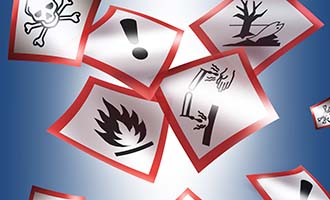 Chemical-related injuries and illnesses are preventable.
Chemical-related injuries and illnesses are preventable.
Being informed about chemicals enables you to make good decisions about the necessary safety precautions to take in your workplace.
What does "hazardous" mean?
Any chemical that can potentially cause harm is considered to be hazardous.
Chemicals can be hazardous if they:
- Can irritate the eyes, skin, or respiratory tract
- Are toxic or carcinogenic (cancer-causing)
- Are corrosive
- Can explode or cause fire
- Create low-oxygen environments (e.g., by displacing or chemically reacting with oxygen in an enclosed or confined space)
Chemicals exist in a variety of forms in the workplace. Some common examples: liquids, stored gases, and particles like dust, powders, sprays, and mists.
Spotting chemicals at work
Chemicals do not always come in pre-packaged containers. Some are harder to spot because they are created and released by work activities or from process equipment. For example:
- Exhaust from fuel-powered vehicles or equipment (e.g., propane-powered forklifts or air compressors)
- Toxic gases created by decomposing organic materials
- Particles in the air coming from hazardous liquids or solid materials during spraying, grinding, or welding.
Get prepared before you walk through your workplace to spot chemicals. Use a job hazard analysis (JHA), Workplace Hazards & Solutions Worksheet, or some other resource to keep track of what you find and note any necessary safety precautions.
If you aren’t sure whether a chemical is hazardous, check information on required safety data sheets (SDSs) and product labels. Request a current SDS and label from distributors or manufacturers if you don't have them.
Chemicals in the air
Check to see if chemicals can be released into the air as vapor, liquid or solid particles, or as a gas during work activities (e.g., spraying, sanding, welding), processes (e.g., combustion, evaporation, fermentation), or from equipment (e.g., metal plating tanks, industrial mixers and conveyors).
Chemicals in the air that are possibly hazardous are called “airborne contaminants” and regulated under the Air Contaminants rule, Chapter 296-841 WAC. Airborne contaminants would necessitate additional safety measures when workers’ exposures are above the regulated limit for the chemical (called a permissible exposure limit or PEL). Depending on the chemical, you may be required to:
- Conduct exposure monitoring of workers' exposures.
- Improve ventilation and safe work procedures and practices.
- Use respirators and other special PPE.
- Provide for medical monitoring.
- Prepare for emergency spills and other releases.
- Provide for worker and supervisor training about specific hazards, safe work procedures and practices, PPE use, housekeeping, and other prevention measures relating to chemical safety.
Exposure Limits (PELs) for Airborne Contaminants
Of the thousands of chemicals used in workplaces, only a few hundred have Permissible Exposure Limits (PELs). PELs are regulated limits set to protect most workers from potential harm.
Air testing or sampling is often the best way to evaluate whether workers exposures are too high. This is also called “exposure monitoring”. Exposure monitoring is a complex task and requires specialized knowledge, equipment, and experience to ensure proper protocols are followed and results are accurate. Industrial hygienists or other specialized safety professionals, such as an L&I consultant, can help.
Right to Know
If you have questions regarding the Right to Know Fee Assessment Program, visit Right to Know.
Creating a Hazard Communication Program
At a minimum, employers are required to develop and follow a written Chemical Hazard Communication Program when employees work with or around hazardous chemicals. Employers who import, manufacture, or distribute hazardous chemicals have additional responsibilities.
If you aren’t sure whether a chemical is hazardous, check information on required safety data sheets (SDSs) and product labels. Request a current SDSs and labels from distributors or manufacturers if you don't have one and be sure to keep a list of the hazardous chemicals currently present in your company’s workplace.
Rule requirements are outlined in the Hazard Communication Standard, WAC 296-901-140.
A sample, customizable hazard communication program template is available in English and Spanish:
The Employer’s Guide to the Hazard Communication Rule provides a helpful checklist, answers to common questions about requirements, training guidance and a standardized label and pictograms to help your company comply with the rule. This guide is also available in Spanish.
Training resources available include:
- A Chemical Hazard Communication Training Kit for instructors
- A narrated training module, Chemical Hazard Communication for Employees
- A Workers' Guide to Hazardous Chemicals-available as an English-Spanish bilingual brochure
- Videos from L&I
- Standardized Hazard Communication Pictograms for labeling (from OSHA.gov)
Chemical Spills
Depending on what’s possible in the workplace, your overall safety program may also need to address emergency response to chemical spills or releases, personal protective equipment (PPE), and Respiratory Protection.